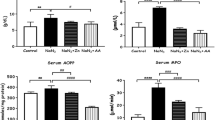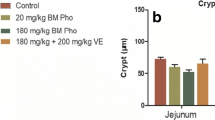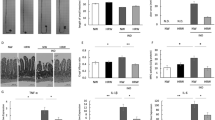Abstract
The aim of our research was to analyze the antioxidant role and efficacy of thermal or salus per aquam (spa) therapy with chlorine–sulphur–bicarbonate mineral water. The study has been performed on 30 rats. The animals were randomized in three groups, each of them composed by ten animals, denominated A, B and C. The A group was the control group and was not subjected to any specific treatment (placebo); the B group has been treated with a standard cycle of hydropinics treatment with mineral water of Therme of Stabia in Castellammare (Naples, Italy) denominated STABIA; the C group was treated with a standard cycle of hydropinic treatment with mineral water of Therme of Stabia in Castellammare (Naples, Italy) denominated SULFUREA. After two weeks of treatment all the rats were sacrificed and blood was collected for the plasmatic determination of reactive oxygen species (ROS). The results demonstrated a significant (P < 0.05) reduction of ROS in B (374 Carr. U. ±73) and C group (399 carr. U. ±62) treated with mineral waters if compared with control group (571 + 69 Carr. U.). In conclusion this study suggests a possible antioxidant effect of chlorine–sulphur–bicarbonate spa hydropinic treatment with a consequent suitable intestinal physiology, with reduction of the functional and organic modifications that can lead to pathological disorders of the gastroenteric diseases in whose pathogenesis the oxidative stress can develop an important role.
Similar content being viewed by others
References
Alberti A, Bolognini L, Macciantelli D, Caratelli M (2000) The radical cation of N,N-diethyl-para-phenylendiamine: a possible indicator of oxidative stress in biological samples. Res Chem Intermed 26(3):253–267
Bacci A (2003) Valutazione clinica controllata delle variazioni dello stress ossidativo con integrazione alimentare alcalinizzante. Med Funzionale 3:28–33
Bancel B, Esteve J, Souquet JC, Toyokuni S, Ohshima H, Pignatelli B (2006) Differences in oxidative stress dependence between gastric adenocarcinoma subtypes. World J Gastroenterol 12(7):1005–1012
Bronzetti G (2000) Antimutagenesis studies of magnesium and calcium salts. J Environ Pathol Toxicol Oncol 19(4):401–413
Cesarone MR, Belcaro G, Carratelli M, Cornelli U, De Sanctis MT, Incandela L, Barsotti A, Terranova R, Nicolaides A (1999) A simple test to monitor oxidative stress. Int Angiol 18:127–130
Ciaccia A, Pinamonti S, Berti S (1983) I radicali liberi dell’ossigeno nelle patologie termali. Il ruolo della terapia termale, edn. Tenne Riolo Bagni 1:16
Cornelli U, Cornelli M, Terranova R, Luca S, Belcaro G (2000) Invecchiamento e radicali liberi. Prog Nutr 3:37–59
Costantino M, Nappi G, Sorrentino S, Lampa E (2005) Effetti dell’idropinoterapia con acqua oligominerale radioemanativa nella litiasi delle vie urinarie. Med Clin Term 57:85–91
Cuomo R, Grasso R, Sarnelli G, Capuano G (2002) Effects of carbonated water on functional dsyspepsia and constipation. Eur J Gastroenterol Hepatol 14:991–999
Dionisio C, Pozzi D, Lisi A, Santoro N, Grimaldi S (1999) Il kit Diacron per il monitoraggio di radicali liberi plasmatici: correlazione a stati di stress e patologici. Report of the Experimental Medicine Institute. Clinical report. National Council of Research, Rome
Franzini A, Luraschi P, Pagani A (1996) Misura diretta dei metaboliti reattivi dell’ossigeno nel siero: valutazione analitica di un nuovo metodo. Biochim Clin 5–6(Suppl 1):89
Gupta AK, Nicol K (2004) The use of sulphur in dermatology. J Drugs Dermatol 3:427–431
Ketterer B (1986) Detoxication reactions of glutathione and glutathione tranferarses. Xenobiotica 16:957
Lison L (1989) Statistica applicata alla biologia sperimentale, ed. Ambrosiana, Milano
Lovaas E (1997) Antioxidative and metal-chelating effects of polyamines. Adv Pharmacol 38:119–149
Mulder GJ, Jakoby WB (1990) Sulfation. In: Mulder GJ (ed) Conjugation reactions in drug metabolism. Taylor and Francis, London, pp 107–116
Olguín-Martínez M, Mendieta-Condado E, Contreras-Zentella M, Escamilla JE, Aranda-Fraustro A, El-Hafidi M, Hernández-Muñoz R (2006) Rate of oxidant stress regulates bilance between rat gastric mucosa proliferation and apoptosis. Free Radic Biol Med 41(8):1325–1337
Oliveira CP, Kassab P, Lopasso FP, Souza HP, Janiszewski M, Laurindo FR, Iriya K, Laudanna AA (2003) Protective effect of ascorbic acid in experimental gastric cancer reduction of oxidative stress. World J Gastroenterol 9(3):446–448
Orrenius S (1984) The multiple roles of glutathione in drug metabolism. Trends Pharm Sci 5:32
Paolucci M, Lamazza C, Quondancarlo C, Riegler G (2001) Effetti di una supplementazione idrica con acqua ad alto contenuto minerale comparata ad una supplementazione con acqua oligominerale in pazienti affetti da stipsi idiopatica cronica. Il Gatroenterologo 3:1–7
Parkas R, Pronai L, Tulassay Z, Selmeci L (2005) Relationship between eradication of Helicobacter pylori and gastric mucosal superoxide dismutase activity. Anticancer Res 25(6C):4763–4767
Pignataro G, Armuzzi A, Valenti A, Iascone E, Marmo R, Lamazza A, Pretaroli AR, Pace V, Leo P, Castelli A, Gasbarrini G (1998) Water supplementation enhances the effect of high-fiber diet on stool frequency and laxative consumption in adult patients with functional constipation. Hepatogastroenterology 45:727–732
Rinaldi L, Gobbi G, Pambianco M, Micheloni C, Mirandola P, Vitale M (2006) Hydrogen sulfide prevents apoptosis of human PMN via inhibition of p38 and capsase 3. Lab Invest 86:391–397
Tanganelli I, Ciccoli L, Tansi R, Borgogni P, Rossi V, Gistri M, Pettinari O, Signorini C, Marisi M (2000) Markers of oxidative stress in diabetic patients. Diabetes Res Clin Pract 50(Suppl 1):S1
Tsan MF, Danis EH, Del Vecchio PJ, Rosano CL (1985) Enhancements of intracellulr glutathione protects endothelial cells against oxidant damage. Biochem Biphys Res Commun 127:270
Zhang ZW, Farthing MJ (2005) The role of vitamin C in Helicobacter Pylori associated gastric carcinogenesis. Chin J Dig Dis 6(2):53–58
Author information
Authors and Affiliations
Corresponding author
Rights and permissions
About this article
Cite this article
Costantino, M., Giuberti, G., Caraglia, M. et al. Possible antioxidant role of SPA therapy with chlorine–sulphur–bicarbonate mineral water. Amino Acids 36, 161–165 (2009). https://doi.org/10.1007/s00726-008-0032-y
Received:
Accepted:
Published:
Issue Date:
DOI: https://doi.org/10.1007/s00726-008-0032-y




